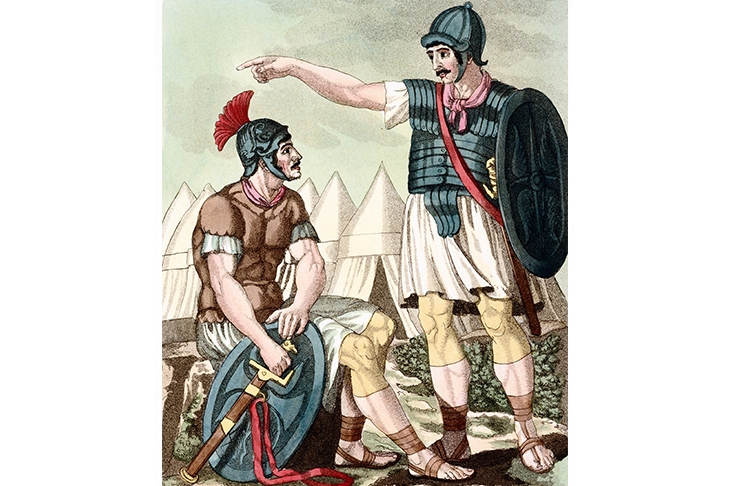The history of an army is essentially the history of its deeds. The history of an army within an army is more intriguing. The Praetorian Guard, a modern term, was founded, or rather formalised, around 27 BC by Augustus for the protection of the emperor and his family. Hitherto, cohors praetoria had been a generic description of the body of troops detailed, ad hoc, for the protection of a general on campaign. This derived from praetorium, the general’s tent next to which they were quartered in camp, which itself derived from praetor, ‘the man who goes before others’. As Gaius Octavius (Octavian) metamorphosed into the first emperor, Augustus, so his cohors praetoria multiplied to become the Praetorian Guard — cohortes praetoriae, the name by which the Romans knew them.
With ten cohorts, each of about 1,000, towards the end of Augustus’s reign — rising perhaps to 15,000 during that of his successor Tiberius — the guard, although relatively small compared with the army as a whole, gradually became the power behind the throne, almost literally so after the building of the Castra Praetoria (to house the cohortes, therefore plural) on the edge of Rome. With accommodation for 15 cohorts, it was ‘a reminder that the emperor’s power was ultimately determined by his capacity to command and control the military force that made the regime possible’.
Indeed, the Castra’s builder, the praetorian prefect Lucius Aelius Sejanus, played with memorably reptilian charm by Patrick Stewart in I Claudius (1976), would himself try to seize the imperial crown, and having failed would pay the price, of course, at the hands of his own praetorians.
These formidable servants of the emperor ‘could either make or break him’, writes Guy de la Bédoyère in this absorbing account of just how they did so variously in the three-and-a-half centuries until Constantine disbanded them in AD 312 and demolished the greater part of their barracks.
Money and other privileges largely secured their loyalty, so ‘their power could only be held in check by an emperor whose guile was greater than their greed’. Because the greed of the one so often exceeded the guile of the other, ‘the Praetorian Guard became one of the most powerful and capricious forces in Roman history’. Or as Gibbon put it:
By thus introducing the Praetorian Guards, as it were, into the palace and the senate, the emperors taught them to perceive their own strength, and the weakness of the civil government.
They were by no means a wholly malign institution, however (or, indeed, stationed only in Rome — one of Bédoyère’s revelatory asides). For example, having effectively put Nero on the throne, steered by Agrippina, they were able to moderate his tendency to unwholesome excess through their rather admirable prefect, the former military tribune Sextus Afranius Burrus, with the help of Nero’s tutor Seneca.
It is well, at the present time, to be reminded of Nero’s ‘descent into theatrical, asinine and perverted self-indulgence [which] almost resulted in the very end of the imperial system’. Because although ‘his reign has gone down in history as the template of tyranny and infamy’, Nero’s common touch ‘meant that he enjoyed a remarkable level of popularity amongst the Roman mob’. They approved of his taking part in chariot races, although he probably did not drive shirtless. And he revelled in appearing before an adulatory crowd, though not so much to tell them how well he was doing as to sing to them, accompanying himself on the lyre. When Burrus had had enough and withdrew from public life, Nero appointed two prefects in his place, one of whom, Ofonius Tigellinus, was prepared to indulge him in every excess, including matricide. Eventually the guard had had enough too, and Nero’s reign and life came to an end, though he retained his self-belief to the last: ‘Qualis artifex pereo.’ (What an artist dies in me.)
Guy de la Bédoyère, despite the evidently defiant retention of Norman orthography, is of the Lincolnshire gentry, and taught for several years in a Kesteven secondary school, which may account for his outstandingly lucid style. He has written widely on Roman history and archaeology, but is perhaps popularly known for his appearances on Time Team, where the requirement for succinctness was everything. His particular interest is coins, and many of the book’s most original insights derive from this. It is aptly illustrated and impeccably referenced, with a helpful glossary and appendices. It does not (mercifully) expound on the design of the praetorians’ sandals or the length of their gladii. It is an altogether impressive piece of compressed scholarship, a thorough study of its subject as well as an engaging history of imperial Rome.






Comments